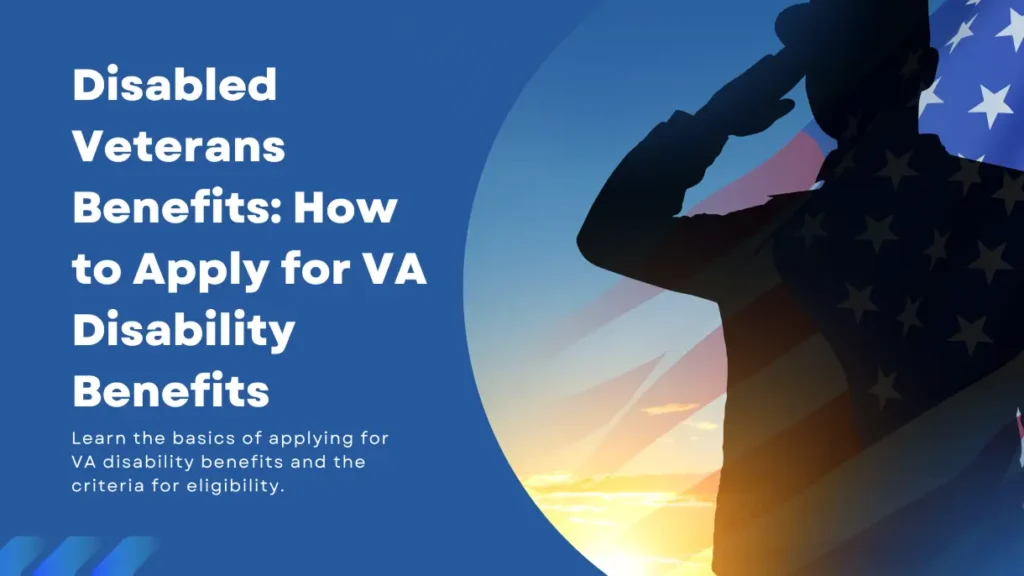Serving in the United States military may lead to great honor, but sometimes it also requires personal sacrifice. Fortunately, there is governmental support for those who endure physical or mental injury as a result of active military service. Disabled veterans benefits are tax-free compensatory monthly benefits on offer for former military members who qualify. Keep reading to find out more about veterans benefits, if you’re eligible, and how to apply, including how to apply for VA health care when receiving separation or retirement orders.
VA Disability Benefits Guide: Key Takeaways
Veterans benefits are available for military personnel who meet the requirements, but there is a process for attaining them. It’s important to know the elements that go into a successful claim and what these benefits entail. Some key points to remember include:
- Purpose. VA benefits are monthly payments for qualified veterans who have lasting injuries or illnesses from their active military service.
- Amount. VA disability benefits can range from $171 monthly (for 10% disability) to $4433 (for 100% disability with multiple dependents).
- Eligibility. Veterans must demonstrate a current disability with a direct cause or aggravation from active military service.
- Application. Veterans must apply for these benefits online, by mail, in person, or with the help of a third-party advocate.
- Evidence. Medical records, discharge/separation papers, and other evidence may be necessary to prove your claim.
- Disability Rating. Your condition will receive a rating and you must be at least 10% disabled to receive any VA disability benefits. The VA disability rating affects the amount of benefits you can receive and is crucial for accessing additional services like VR&E if your service-connected disability limits or prevents you from working.
- Waiting Period. It currently takes about 147 days for the VA to make a decision about your claim.
- Appeals. If you don’t receive claim approval the first time, you have a right to appeal. Contacting a lawyer will increase your chances of approval.
What Are Veterans Disability Benefits?
Veterans disability benefits are tax-free monthly payments for former military members with a service-related condition. That means that their current disability is a result of or got worse from active military service.
The compensation rate will depend on the degree of the veteran’s service connected disabilities. This determination will come from the Veterans Administration and will influence how much a veteran receives. A higher disability rating means a larger monthly payment.
Understanding VA Disability Ratings
Disability ratings are percentages the U.S. Department of Veterans Affairs assigns for injuries or illnesses from a veteran’s military service. The basis of the rating stems from the severity of the disability. It also represents how much the disability decreases overall health and ability to function.
A disability rating comes from the following information:
- Evidence supplied by the applicant, including doctor’s reports and test results.
- The results of a veteran’s VA claim exam (an official examination by the VA some applicants must submit to).
- Information that comes from other government sources, like federal agencies.
Once the VA determines an applicant’s disability rating, then that affects the compensation rate. The VA also uses an individual’s disability rating to help determine eligibility for other benefits, like VA healthcare and VA health care benefits.
Who Qualifies for Veterans Affairs Benefits?
Eligible veterans of the U.S. Armed Forces, as well as their spouses and dependents, may qualify for VA benefits. This includes the U.S. Army Reserve and National Guard. Additionally, survivors of deceased veterans, including parents, may qualify.
At a base level, however, to receive VA benefits, an individual must demonstrate:
- That they have a current condition that affects the mind and/or body
- That they served on active duty, active duty for training, or inactive duty training
Additionally, an applicant’s claim must be categorized as one of the following:
- In-service disability. This means they experienced illness or injury during their military service and can link this condition to their current disability.
- Pre-service disability. This means the service member had an illness or injury before joining the military and serving made it worse.
- Post-service disability. This means the veteran has a disability related to their active-duty service that didn’t appear until after their service was complete.
Finally, an applicant must not have “dishonorable discharge” or “bad conduct” status, and they can not still be active duty service members. However, anyone with a questionable relief of duty may apply for a discharge upgrade if it connects to certain categories.
Types of VA Health Care Benefits Available for Disabled Vets?
In addition to the monthly compensation payment, there are other types of VA benefits available for disabled veterans. These include:
- Automobile Allowance. This program offers financial assistance to severely disabled veterans so they can purchase or adapt a vehicle to accommodate a disability.
- Clothing Allowance. This is an annual stipend for disabled veterans with unique clothing needs as a result of their service-connected illness/injury.
- Special Adapted Housing (SAH)/Home Adaptation Grants. This provides monetary assistance to help severely disabled veterans obtain or adapt suitable housing.
- Service Disabled Veterans’ Insurance (S-DVI). This gives life insurance to disabled veterans within two years of receiving a VA rating for disability. Totally disabled veterans get this insurance premium free with the option to purchase higher coverage amounts.
- Veterans’ Mortgage Life Insurance (VMLI). This provides disabled veterans with mortgage life insurance protection if they have approval for VA Specially Adapted Housing (SAH).
- Veterans Group Life Insurance (VGLI). This allows veterans to convert their SGLI coverage to VGLI or a commercial policy. Veterans must apply within one year and 120 days from discharge and provide necessary documentation.
- Vocational Rehabilitation and Employment (VR&E). This program offers disabled veterans educational and training resources to help them obtain and maintain suitable employment.
- Education Assistance. This provides disabled veterans with education benefits meant to assist them in obtaining a degree or pursuing other eligible education/training.
- Dependents’ Educational Assistance (DEA). This benefit provides the dependents or survivors of veterans with assistance so they can obtain additional education or training.
All of the above disabled veterans benefits are available once you receive your disability rating. However, each benefit will likely require a separate application. This is why it helps to have a lawyer or advocate to guide disabled veterans through the process.
Getting a free Veterans Advantage discount card is another way for disabled veterans to take advantage of shopping savings. There are many benefits out there for disabled veterans to help them manage after their sacrifice for the country.
How to Apply for Disabled Veterans Benefits
There is a very specific process to follow for those veterans applying for veterans affairs benefits. For individuals who think they may satisfy the eligibility requirements, here are the steps.
Step 1: Gather Evidence
In order to effectively apply for benefits you will need to be able to demonstrate at least 10% disability.
As such, if you have any of the following relevant items, get them in order to submit with your claim:
- Discharge or separation papers (the DD-214 or equivalent).
- VA service treatment records
- Supporting statements (from family members, friends, people you served with, etc)
- Private medical records and hospital reports.
If you don’t quite have everything ready for a Fully Developed Claim, it’s still smart to start the process. That’s because filing an “intent to file” will register you with an earlier claim date. But you’ll then have a year to get paperwork together and complete your submission.
Step 2: Choose How to Apply
According to the U.S. Department of Veterans Affairs, there are several ways you may choose to file an application.
- Online. This is the easiest way to apply according to the VA. Get started here: https://www.va.gov/disability/file-disability-claim-form-21-526ez/introduction
- By Mail. You can file your claim by mail by downloading the VA Form 21-526EZ. Print the form, fill it out, and send it to:
- Department of Veterans Affairs Claims Intake Center PO Box 4444 Janesville, WI 53547-4444
- By Fax: If you’re in the U.S., you may download the VA Form 21-526EZ form and fax your application to 844-531-7818. If you’re outside the U.S., fax your application to 248-524-4260.
- In Person. You may bring your application to a local VA regional office.
- With the help of a third-party advocate. Getting assistance from a VA-accredited representative can really help simplify the process. This may include a claims agent, a Veterans Service Organization (VSO) representative, or an accredited attorney.
- Dependency and Indemnity Compensation. This benefit is available for survivors or dependents of a service member or veteran who has passed away. You can apply for Dependency and Indemnity Compensation online, by mail, in person, or with the help of a third-party advocate.
Step 3: Await VA Determination
Once an applicant submits their claim to the VA for consideration, the VA will review it. Currently, the average wait time is 147.2 days.
The time it takes to review your case will depend on the following:
- The type of claim you file
- The number and complexity of injuries or disabilities you claim
- How long it takes to collect and confirm the evidence necessary to decide your claim
Step 4: Check Your Claim Status
The VA gives you the ability to check your claim status online. You can use this tool to check the status of a VA claim, decision review, or appeal for all types of VA benefits. However, you will need to create an official Login.gov, ID.me, DS Logon, or My HealtheVet account.
If you don’t have an account, you can create one here.
Work With a VA-Accredited Lawyer For Help With Your Claim
Navigating all the steps to a successful VA benefits claim can feel overwhelming. That’s why it’s really positive that the U.S. Veterans Administration allows veterans to have assistance from accredited representatives.
If you have questions anywhere in the process, a VA-accredited attorney can help offer expert guidance on acquiring disabled veterans benefits. They will also provide personalized help, letting you know which programs are a fit for your situation. They can assist survivors in applying for Dependency and Indemnity Compensation and other benefits. Additionally, they can help you correctly complete applications, submit necessary evidence, and make the entire process smoother. Plus, if the VA denies your claim at first, a lawyer can represent you in an appeal.
Dealing with disability requires a big life adjustment, so make sure you have the support you need along the way.

